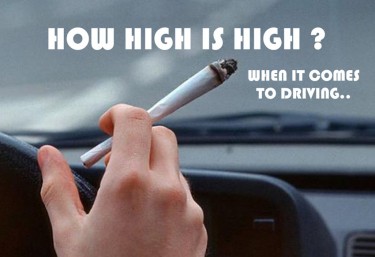
Why Testing impairment with THC levels is not an accurate benchmark
When it comes to stoner culture, there’s an unwritten understanding that reverberates through the smoke-filled rooms of seasoned stoners: the presence of THC in your system is not a definitive marker of impairment. This nuanced perspective, born out of countless personal experiences and observations, contrasts sharply with the blunt instrument approach adopted by law enforcement agencies across the nation.
For years, the legal threshold of THC content in one’s bloodstream has been wielded like a gavel, ready to pronounce judgement on one’s ability to operate a vehicle safely. But the science behind this method of assessment is far from settled, and voices from within the very institutions that enforce these rules are beginning to question their validity.
Enter the arena, a researcher from the Justice Department, who recently cast a spotlight on the glaring discrepancies between THC levels and actual impairment, especially among those who consume cannabis regularly. This acknowledgment from a figure within a federal agency marks a significant pivot in the conversation around cannabis, driving, and the law.However, we have had federal judges make comments which impacted absolutely nothing save for a few stoners who said, “Look, the feds agree!”
Nonetheless, it’s a recognition that the current metrics might not just be flawed but could be fundamentally misaligned with the realities of cannabis consumption and its effects on the human body.
The implications of this critique extend far beyond the legal skirmishes on the roadside; they touch on the very heart of how society understands, regulates, and integrates cannabis use within the framework of daily life.
This article aims to dive deep into the murky waters of THC impairment testing while driving. We’ll explore the scientific underpinnings (or lack thereof) that inform current policies, the peculiarities of THC metabolism that challenge the notion of a one-size-fits-all impairment standard, and the potential paths forward in creating a more nuanced and just system of evaluation. Through this exploration, we seek to illuminate the complexities of cannabis impairment, advocating for a shift from rigid, THC-centric measures towards approaches that genuinely reflect an individual’s capacity to drive safely.
A recent Justice Department research says states may need to “get away from” per se THC limits for determining cannabis impairment while driving.
“The problem is we’ve funded this research that pretty conclusively shows that the THC concentration in the blood is not particularly well-correlated with impairment for driving,” said Frances Scott, a DOJ physical scientist, on a recent podcast. “Maybe what we need to do is kind of get away from that idea that we can sort of have a number when it comes to marijuana and have that mean that you’re impaired.”
One major issue is that frequent and infrequent marijuana users metabolize THC differently. “If you have chronic users versus infrequent users, they have very different concentrations correlated to different effects,” Scott explained. “So the same effect level, if you will, will be correlated with a very different concentration of THC in the blood of a chronic user versus an infrequent user.”
A recent study funded by the federal government identified new methods to test for recent cannabis use that accounts for lingering THC metabolites (Hound Labs, 2022). But we still lack “a good metric” for impairment.
“With alcohol, we per se laws—that’s the 0.08 [blood alcohol content], right?” said Scott. “If we demonstrate that your blood alcohol content is over 0.08, that’s all I have to do to prove impairment.”
But THC is more complex. “Maybe it’s not a blood measure or a breath measure,” she said. While the Justice Department continues researching a marijuana breathalyzer, they’re also funding alternative tests like saliva swabs and assessments of eye functioning.
Some research has found little link between THC blood levels and crash risk. A 2019 study concluded drivers at the legal limit of 2-5 ng/mL were no more likely to crash than sober drivers (Sewell, 2019). And a Congressional Research Service review found “conflicting results” on crashes and THC levels (CRS, 2019).
With unclear science, lawmakers want clarity. A 2022 House bill supported developing “an objective standard” for marijuana impairment. And Senator John Hickenlooper requested an update on research barriers inhibiting standardized cannabis impairment tests.
But the path forward remains unclear. “We may need better tests,” said Scott. Until then, per se THC limits seem unreliable for determining driver impairment.
With blood THC levels an unreliable metric, the question lingers: how can we accurately measure marijuana impairment, especially for drivers? The path forward is unclear.
“We may need better tests,” said DOJ researcher Frances Scott recently. But until new technology emerges, assessing impairment likely requires in-person evaluations. These could gauge reaction times, decision-making abilities, and motor coordination through tablet apps or roadside maneuvers.
One app, DRUID, claims to measure marijuana impairment. I once interviewed its developer, who said DRUID assesses hand-eye coordination, time estimation, and inhibitory control. While results aren’t foolproof, it aims to provide an objective benchmark. But most law enforcement lacks access to such apps currently.
Thus, we largely rely on field sobriety tests for cannabis. These include the horizontal gaze nystagmus test, which measures jerky eye movements linked to intoxication. But results aren’t cannabis-specific and such exams bring subjectivity. “There are no conclusive tests to measure marijuana impairment,” said Jolene Forman of the Drug Policy Alliance.
Plus, even if a driver seems impaired, determining the substance’s role is tough. “Because cannabis can be detected in bodily fluids for up to a month after last use, it is inherently difficult to determine whether or not an individual operated a vehicle while impaired,” said NORML deputy director Paul Armentano.
This lack of clarity poses issues headed toward potential federal legalization. Those impaired on marijuana may dodge charges today. And frequent consumers like medical patients might fail sobriety tests despite no recent use.
“Someone who consumes cannabis daily or multiple times per day is more likely to have residual THC in their system that exceeds per se limits but is not necessarily impaired,” said Armentano.
Until we have better impairment measures, the clearest way forward is two-fold. One, set traffic safety laws based on actual impairment versus THC levels. Two, improve and standardize field impairment exams to rely less on blood draws and more on observable intoxication signs. There is no panacea currently to determine cannabis impairment for drivers. But bolstering roadside exams can help clarify justice, especially as marijuana gains legal traction nationwide.
Determining cannabis impairment for drivers remains a perplexing challenge. Unlike alcohol tests, THC blood levels don’t accurately gauge intoxication. “We may need better tests,” said Scott. But until then, we must base roadside impairment on observables not numbers.
Still, accurately measuring marijuana intoxication levels is crucial, especially headed toward likely federal legalization. Relying solely on subjective sobriety exams brings inconsistencies in charges and convictions. And without clarity, frequent consumers like medical patients may fail tests despite no recent usage due to lingering THC.
“Because cannabis can be detected in bodily fluids for up to a month after last use, it is inherently difficult to determine whether or not an individual operated a vehicle while impaired,” said Armentano.
The need for innovation is urgent. Apps like DRUID show early promise in objectively measuring cannabis impairment via assessments of motor skills and cognitive functioning. While not yet foolproof, technology may propel solutions.
“There are no conclusive tests to measure marijuana impairment,” said Forman. Conclusiveness is needed to determine driver fitness, administer justice properly, and shape intelligent roadway policies centered on actual intoxication levels versus metabolism technicalities.
Whoever cracks the code on measuring cannabis impairment stands to gain big. Not only fame as a champion of safe, legal marijuana access, but likely billions in technology licensing and implementation.
“That’s also well-understood,” said Scott on alcohol tests’ accuracy. We need similar understanding of marijuana markers that determine real-time impairment regardless of usage frequency. Until then, the race is on to develop reliable cannabis tests to clarify justice, better protect all motorists, and allow informed usage policies for marijuana-friendly worlds ahead. The innovator who creates a foolproof impairment gauge will help drive that future while securing their own fortune.
SOURCE URL: https://www.marijuanamoment.net/scientists-develop-new-method-to-test-
for-recent-marijuana-use-with-96-accuracy-in-federally-funded-driving-simulation-study/
MORE ABOUT DRIVING ON CANNABIS, READ ON…
DRIVING HIGH – HOW HIGH IS TOO HIGH WHEN IT COMES TO DRIVING?
- SEO Powered Content & PR Distribution. Get Amplified Today.
- PlatoData.Network Vertical Generative Ai. Empower Yourself. Access Here.
- PlatoAiStream. Web3 Intelligence. Knowledge Amplified. Access Here.
- PlatoESG. Carbon, CleanTech, Energy, Environment, Solar, Waste Management. Access Here.
- PlatoHealth. Biotech and Clinical Trials Intelligence. Access Here.
- Source: http://cannabis.net/blog/opinion/the-amount-of-thc-in-your-system-does-not-determine-impairment-when-driving-says-new-federal-go
- :has
- :is
- :not
- $UP
- 08
- 2019
- 2022
- a
- abilities
- ability
- About
- absolutely
- access
- Accounts
- accuracy
- accurate
- accurately
- acknowledgment
- across
- actual
- administer
- adopted
- advocating
- After
- agencies
- agency
- ahead
- aims
- Alcohol
- All
- Alliance
- allow
- also
- alternative
- among
- amount
- an
- and
- app
- approach
- approaches
- apps
- ARE
- Arena
- around
- article
- AS
- assesses
- Assessing
- assessment
- assessments
- At
- away
- barriers
- base
- based
- BE
- because
- been
- Beginning
- behind
- Benchmark
- Better
- between
- Beyond
- Big
- Bill
- billions
- blood
- body
- bolstering
- born
- Breath
- bring
- Brings
- but
- by
- CAN
- cannabis
- Capacity
- centered
- challenge
- champion
- charges
- claims
- clarity
- clearest
- code
- cognitive
- comes
- comments
- complex
- complexities
- concentration
- concluded
- Conflicting
- Congressional
- consume
- Consumers
- consumption
- content
- continues
- contrasts
- control
- coordination
- correlated
- could
- countless
- Crash
- creates
- Creating
- crucial
- Culture
- Current
- Currently
- daily
- day
- Decision Making
- deep
- definitive
- demonstrate
- Department
- deputy
- Despite
- detected
- Determine
- determining
- develop
- Developer
- developing
- different
- differently
- difficult
- Director
- dive
- do
- Dodge
- does
- DoJ
- don
- draws
- drive
- driver
- drivers
- driving
- drug
- Druid
- due
- Early
- effect
- effects
- emerges
- enforce
- enforcement
- especially
- Ether (ETH)
- evaluation
- evaluations
- Even
- exceeds
- Experiences
- explained
- exploration
- explore
- extend
- eye
- FAIL
- FAME
- far
- Federal
- Federal government
- Feds
- few
- field
- Figure
- fitness
- flawed
- For
- Fortune
- Forward
- found
- Framework
- Frequency
- frequent
- from
- functioning
- fundamentally
- funded
- funding
- future
- Gain
- Gains
- gauge
- genuinely
- get
- good
- Government
- had
- Have
- headed
- Heart
- help
- High
- Horizontal
- House
- How
- How High
- However
- HTTPS
- human
- i
- idea
- identified
- if
- illuminate
- impacted
- impairment
- implementation
- implications
- improve
- in
- include
- inconsistencies
- individual
- inform
- informed
- inherently
- Innovation
- Innovator
- institutions
- instrument
- Integrates
- Intelligent
- interviewed
- into
- issue
- issues
- IT
- ITS
- John
- jpg
- judges
- just
- Justice
- Justice Department
- Kind
- Labs
- Lack
- lacks
- largely
- Last
- Law
- law enforcement
- lawmakers
- Laws
- Legal
- legalization
- less
- Level
- levels
- Licensing
- Life
- like
- likely
- LIMIT
- limits
- LINK
- linked
- little
- ll
- major
- make
- marijuana
- marker
- May..
- maybe
- mean
- measure
- measures
- measuring
- medical
- method
- methods
- metric
- Metrics
- might
- Month
- more
- most
- Motor
- movements
- much
- multiple
- must
- nation
- Nationwide
- necessarily
- Need
- needed
- New
- no
- nothing
- Notion
- nuanced
- number
- numbers
- objective
- objectively
- observations
- of
- on
- once
- ONE
- only
- operate
- operated
- or
- out
- over
- own
- panacea
- particularly
- path
- paths
- patients
- Paul
- per
- personal
- perspective
- physical
- Pivot
- plato
- Plato Data Intelligence
- PlatoData
- podcast
- policies
- policy
- poses
- potential
- presence
- pretty
- Problem
- promise
- Propel
- properly
- protect
- Prove
- provide
- question
- Race
- RE
- reaction
- Read
- ready
- real-time
- realities
- recent
- recently
- recognition
- reflect
- Regardless
- regularly
- reliable
- rely
- relying
- remains
- report
- requested
- requires
- research
- researcher
- Results
- review
- right
- rigid
- Risk
- Role
- Rooms
- rules
- s
- safe
- safely
- Safety
- Said
- Saliva
- same
- Save
- says
- Science
- scientific
- Scientist
- scott
- seasoned
- securing
- Seek
- seem
- seems
- Senator
- service
- set
- Settled
- Shape
- she
- shift
- show
- Shows
- significant
- Signs
- similar
- skills
- So
- sober
- Society
- solely
- Solutions
- Someone
- sort
- Spotlight
- standard
- standardized
- stands
- States
- Still
- Study
- subjective
- substance
- such
- Supported
- system
- T
- Tablet
- Technology
- test
- Testing
- tests
- than
- that
- THC
- The
- their
- then
- There.
- These
- they
- this
- those
- threshold
- Through
- time
- times
- to
- today
- too
- touch
- tough
- toward
- towards
- traction
- traffic
- two
- two-fold
- unclear
- underpinnings
- understanding
- understands
- unlike
- until
- Update
- urgent
- URL
- Usage
- use
- User
- users
- validity
- vehicle
- Versus
- very
- via
- VOICES
- want
- Waters
- Way..
- we
- were
- What
- when
- whether
- which
- while
- WHO
- will
- with
- within
- without
- world’s
- years
- yet
- you
- Your
- zephyrnet













